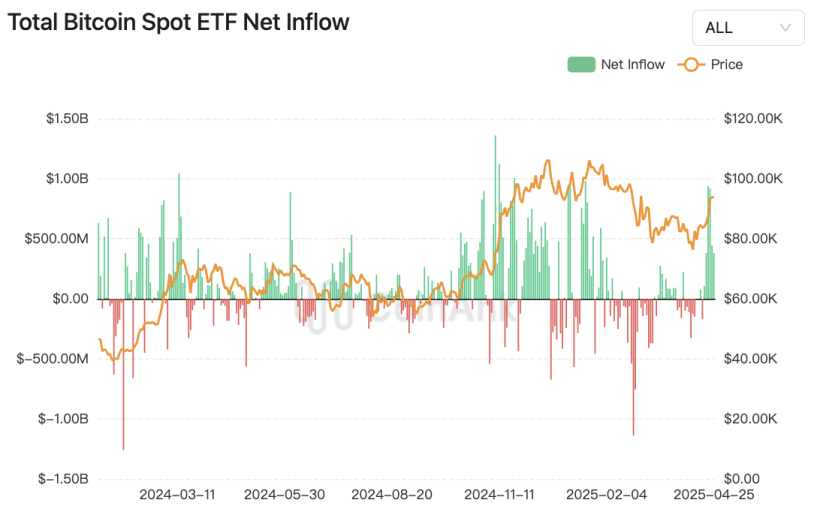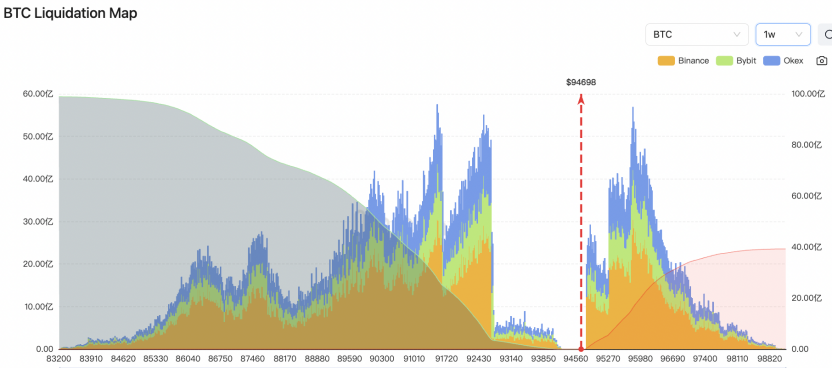This Week's Preview (4.28-5.4),** Major Concept Sectors Rotate In, GBTC Annual Revenue of $268 Million, Surpassing Total Income of Other ETFs**
Table of Contents:
Large Token Unlock Data for This Week;
Overview of the Crypto Market, Quick Read on Weekly Popular Coins' Price Changes/Fund Flows;
Bitcoin Spot ETF Dynamics;
BTC Liquidation Map Data Interpretation;
Key Macroeconomic Events and Crypto Market Highlights for This Week.
1. Large Token Unlock Data for This Week;
This week, multiple tokens will undergo a one-time unlock. The following are sorted by unlock value:
Tokens such as SUI, OMNI, OP, etc., will see significant unlocks next week, including:
Sui (SUI) will unlock approximately 74 million tokens at 8 AM on May 1, accounting for 2.28% of the current circulating supply, valued at about $267 million;
Omni Network (OMNI) will unlock approximately 15.98 million tokens at 7 PM on May 2, accounting for 83.51% of the current circulating supply, valued at about $42.2 million;
Optimism (OP) will unlock approximately 31.34 million tokens at 8 AM on April 30, accounting for 1.89% of the current circulating supply, valued at about $25.7 million;
Kamino (KMNO) will unlock approximately 229 million tokens at 8 PM on April 30, accounting for 16.98% of the current circulating supply, valued at about $14.5 million;
Ethena (ENA) will unlock approximately 40.63 million tokens at 3 PM on May 2, accounting for 0.73% of the current circulating supply, valued at about $14.2 million;
ZetaChain (ZETA) will unlock approximately 44.26 million tokens at 8 AM on May 1, accounting for 5.67% of the current circulating supply, valued at about $11.3 million.

The unlocking situation of these projects may have varying degrees of impact on the related markets. The above times are in UTC+8, and the data is from CoinAnk.
We believe that the concentrated token unlock events this week can be interpreted from both supply-demand dynamics and project backgrounds. SUI leads with an unlock scale of $267 million, but it only accounts for 2.28% of the circulating supply, making short-term selling pressure relatively controllable. Historical data shows that SUI has experienced minimal price fluctuations after multiple large unlocks, possibly due to the project team hedging risks in advance through ecological cooperation (such as integrating USDC) and marketing strategies. In contrast, OMNI's unlock ratio is as high as 83.51%, and the sudden increase in circulating supply may trigger significant volatility, necessitating caution against concentrated selling by holders.
Tokens like OP and ENA have unlock ratios below 5%, which is considered a regular release pace. Combining past cases (such as OP showing strong price resilience after multiple unlocks in 2024), such low-ratio unlocks have limited market impact, but attention should be paid to market sentiment during the same period. Notably, ZETA and KMNO have unlock ratios of 5.67% and 16.98%, respectively; although their absolute values are not high, if project ecological progress lags, it may amplify negative effects.
From a strategic perspective, project teams tend to release positive information before unlocks, such as SUI recently promoting gaming hardware SUIPlay0XI and introducing institutional cooperation, possibly to prepare for mitigating selling pressure. Additionally, high circulating supply projects (like SUI, which currently has over 270 million in circulation) have better market depth and stronger liquidity buffering capabilities, while emerging projects (like OMNI) are more susceptible to shocks due to insufficient liquidity.
Therefore, investors need to assess different risks: mainstream tokens like SUI have controllable short-term risks but should monitor subsequent unlock rhythms; high-ratio projects like OMNI exhibit prominent volatility risks; OP and ENA may continue stable trends. It is recommended to dynamically adjust strategies based on project fundamentals and on-chain data post-unlock (such as changes in whale holdings).

2. Overview of the Crypto Market, Quick Read on Weekly Popular Coins' Price Changes/Fund Flows
According to CoinAnk data, over the past week, the crypto market, categorized by concept sectors, saw net inflows in sectors such as Avalanche ecosystem, Optimism ecosystem, Arbitrum ecosystem, Solana ecosystem, #BSC, Ethereum ecosystem, and Launchpool.
In the past 7 days, the following tokens topped the price increase list (selected from the top 500 by market cap): PENGU, MYRO, VIRTUAL, ARC, and MICHI, among others, showing relatively high increases, and strong tokens should continue to be prioritized for trading opportunities this week.

3. Bitcoin Spot ETF Fund Dynamics.
According to CoinAnk data, last week, the cumulative net inflow into U.S. Bitcoin spot ETFs reached $3.0629 billion, with net inflows recorded for all five trading days. Nearly 16 months after the launch of the spot Bitcoin ETF, Grayscale's GBTC continues to dominate in revenue generation, with an implied annual income exceeding $268 million, surpassing the total income of all other Bitcoin ETFs ($211 million).
From a researcher's perspective, the recent fund flows in U.S. Bitcoin spot ETFs show significant differentiation. Data indicates that last week (ending April 28, 2025), Bitcoin spot ETFs had a cumulative net inflow of $3.06 billion, maintaining net inflows for five consecutive trading days, indicating that market demand for crypto asset allocation remains resilient. However, Grayscale's GBTC exhibits a unique market position: despite its funds being in a long-term net outflow state (with historical cumulative outflows exceeding $20 billion), its implied annual income remains as high as $268 million, surpassing the total income of all other Bitcoin ETFs ($211 million), primarily due to its large existing scale and high fee structure.
In terms of competitive landscape, emerging ETFs like BlackRock's IBIT and Fidelity's FBTC continue to attract incremental funds with low fee strategies, for instance, IBIT once recorded a peak net inflow of $2.15 billion in a single week. However, Grayscale still maintains revenue dominance through brand accumulation and first-mover advantage. This dual-track phenomenon of "existing scale generating income, incremental competition diverting funds" reflects the transition of the ETF market from early monopoly to diversified competition. Notably, although GBTC has long faced outflow pressure, recent data shows that its daily net outflows have decreased from tens of millions to millions, with occasional net inflows, suggesting a potential marginal improvement in market sentiment.
From a macro perspective, the total net asset value of spot Bitcoin ETFs has surpassed $100 billion, accounting for over 5% of Bitcoin's total market cap, and their fund flows have become an important factor influencing price volatility. Researchers believe that the current structural contradictions in the ETF market (concentrated income vs. dispersed funds) may drive product innovation, such as Grayscale launching a mini BTC ETF to attempt to balance fees and scale, while institutions like BlackRock consolidate market share through continuous inflows. Future attention should be paid to regulatory policy changes and the rebalancing effects of institutional investor behavior on fund flows.

4. BTC Liquidation Map Data.
CoinAnk liquidation map data shows that if BTC breaks through $99,000, the cumulative short liquidation intensity on major CEXs will reach $3.925 billion. Conversely, if Bitcoin falls below $90,000, the cumulative long liquidation intensity on major CEXs will reach $5.432 billion.
We believe that the current price of Bitcoin is near a critical threshold, and the long-short game presents a significant asymmetric risk structure. If BTC breaks through $99,000, it may trigger $3.925 billion in short liquidations, stemming from the concentration of stop-loss orders for many high-leverage short positions when prices rise, creating a "short squeeze" effect. Such chain liquidations may exacerbate liquidity fluctuations, pushing prices further beyond resistance levels. Conversely, if it falls below $90,000, the liquidation pressure of up to $5.432 billion in long positions will be released, reflecting the market's vulnerability under the expectation of a pullback, potentially triggering a spiral decline of long liquidations.
Data from different periods shows that liquidation thresholds and intensities dynamically change with market leverage levels and position structures. For example, data from February 2025 indicated that breaking below $95,000 only triggered $229 million in long liquidations, but similar thresholds in April of the same year saw intensities soar to several billion dollars, indicating that market risk exposure significantly amplifies during bull markets. It is important to note that the liquidation map reflects relative intensity rather than absolute amounts; its essence is an assessment of the probability of liquidity shocks when prices reach specific areas. The current stark disparity in long and short liquidation intensities ($5.432 billion vs. $3.925 billion) suggests that the market is more sensitive to pricing down risks, possibly related to the recent overcrowding of long positions in the derivatives market. This nonlinear liquidation pressure may cause prices to exhibit extreme volatility near critical levels, and investors should be cautious of extreme market conditions triggered by liquidity exhaustion.
5. Key Macroeconomic Events and Crypto Market Highlights for This Week.
Date
Day
Important Events
April 28
Monday
Federal elections in Canada
April 30
Wednesday
- U.S. March Core PCE Price Index Year-on-Year (22:00)
- World Gold Council releases the first quarter "Gold Demand Trends" report
May 1
Thursday
- U.S. Initial Jobless Claims for the week (20:30)
- U.S. April ISM Manufacturing PMI (22:00)
- Bank of Japan announces interest rate decision and economic outlook
May 2
Friday
- U.S. April Unemployment Rate (20:30)
- U.S. April Seasonally Adjusted Non-Farm Payrolls (20:30)
We believe that the core contradiction in the crypto market this week centers on the interplay between U.S. economic data and policy dynamics. Friday's non-farm payroll and unemployment rate data will serve as key guidance for expectations regarding the Federal Reserve's monetary policy: if the data is weak (such as new jobs falling short of expectations or an increase in the unemployment rate), it may strengthen the market's bets on four rate cuts within the year, thereby boosting risk assets; conversely, if the data is strong, it will heighten concerns about the duration of high interest rates, suppressing market sentiment. Currently, BTC's implied volatility has dropped to a low of 45%, indicating a lack of consensus among investors regarding short-term direction, but this also sets the stage for a volatility rebound following the data release.
It is noteworthy that Trump's policies continue to exert persistent disturbances on the market. Previously, his tariff policies led to significant volatility in crypto assets (with BTC's decline significantly greater than that of ETH), while recent easing of rhetoric has triggered a market reversal. This policy uncertainty has enhanced the correlation between crypto assets and traditional risk assets, especially against the backdrop of weak U.S. stocks without signs of recession, potentially accelerating the rotation of funds between equity, debt markets, and the crypto market.
The specific impact pathways on the crypto market may exhibit bidirectional volatility characteristics: on one hand, weak economic data leading to rate cut expectations may push BTC to test the psychological threshold of $100,000; on the other hand, the resilience of the job market may continue the current oscillation pattern. In the medium term, attention should be paid to potential black swan events on the policy front (such as new tariff measures) and the repeated adjustments of liquidity expectations. It is recommended that investors closely monitor changes in hedging demand in the options market and the sustainability of ETF fund inflows, as these two indicators will reflect institutional assessments of systemic risk.
免责声明:本文章仅代表作者个人观点,不代表本平台的立场和观点。本文章仅供信息分享,不构成对任何人的任何投资建议。用户与作者之间的任何争议,与本平台无关。如网页中刊载的文章或图片涉及侵权,请提供相关的权利证明和身份证明发送邮件到support@aicoin.com,本平台相关工作人员将会进行核查。



